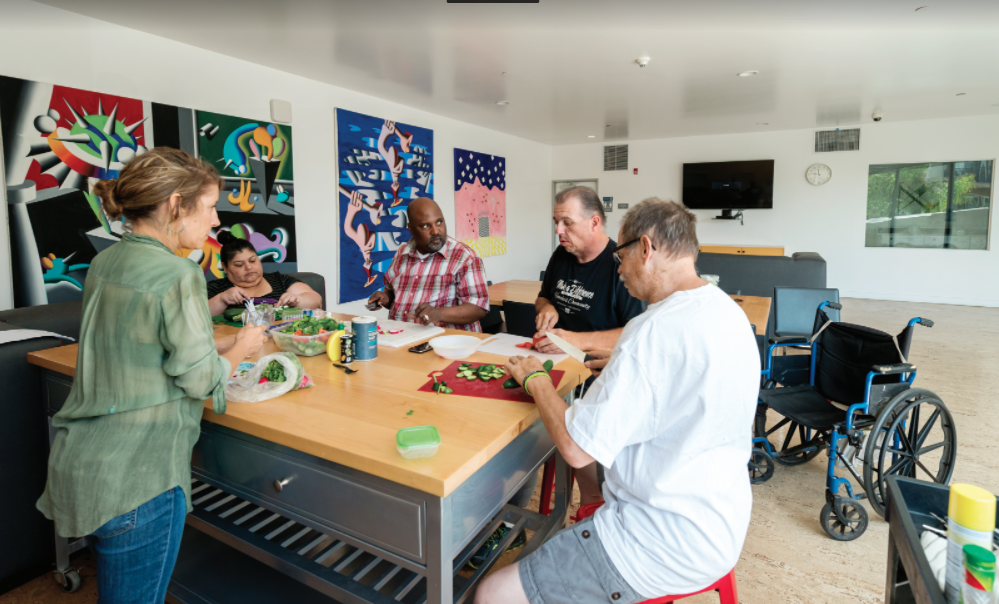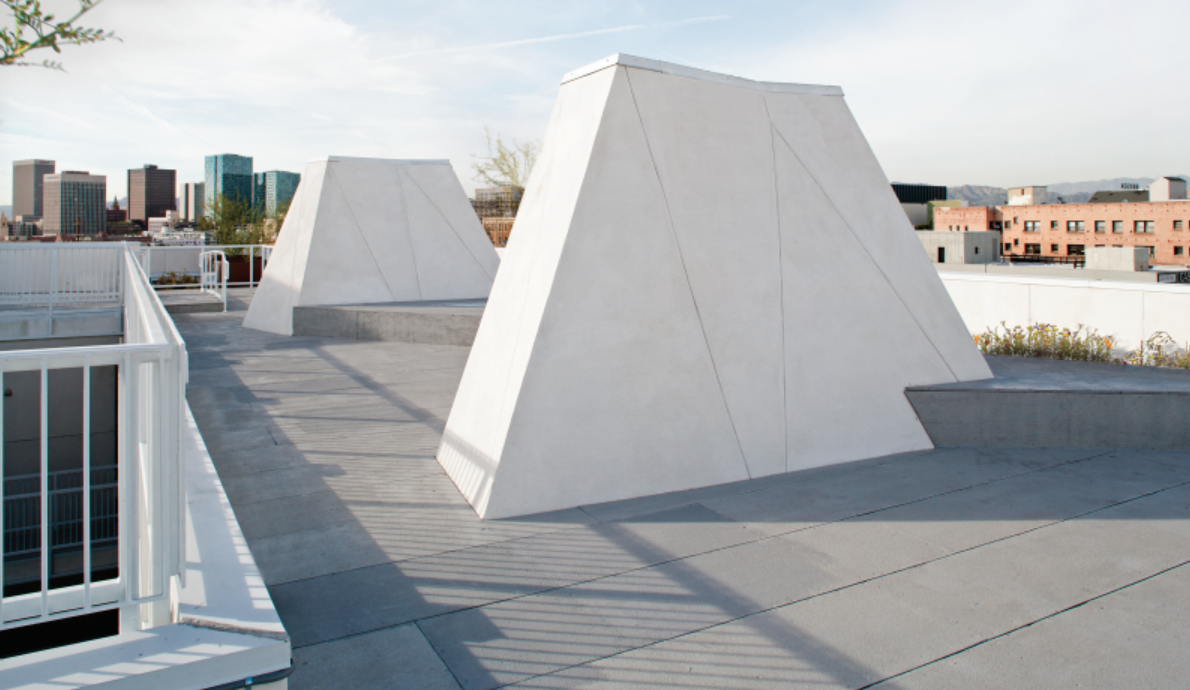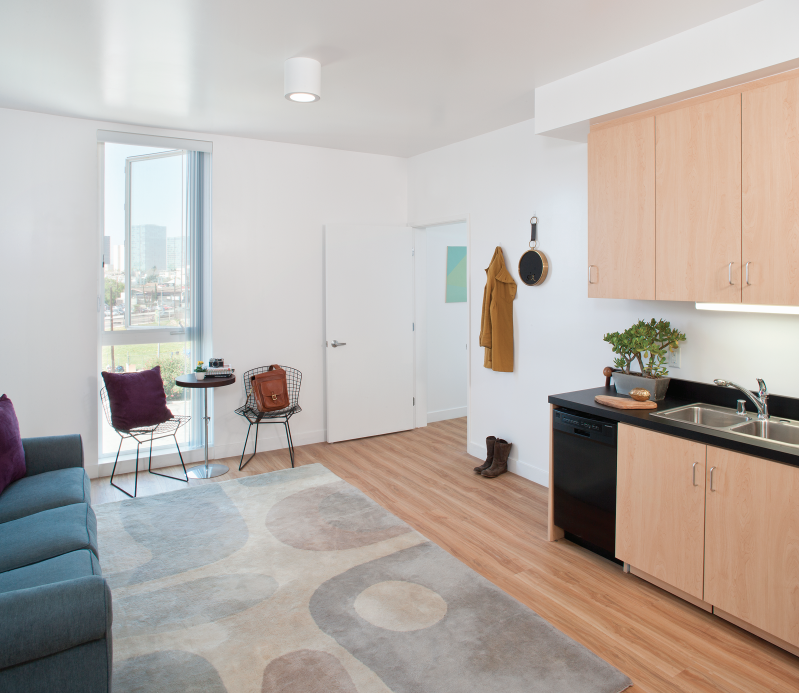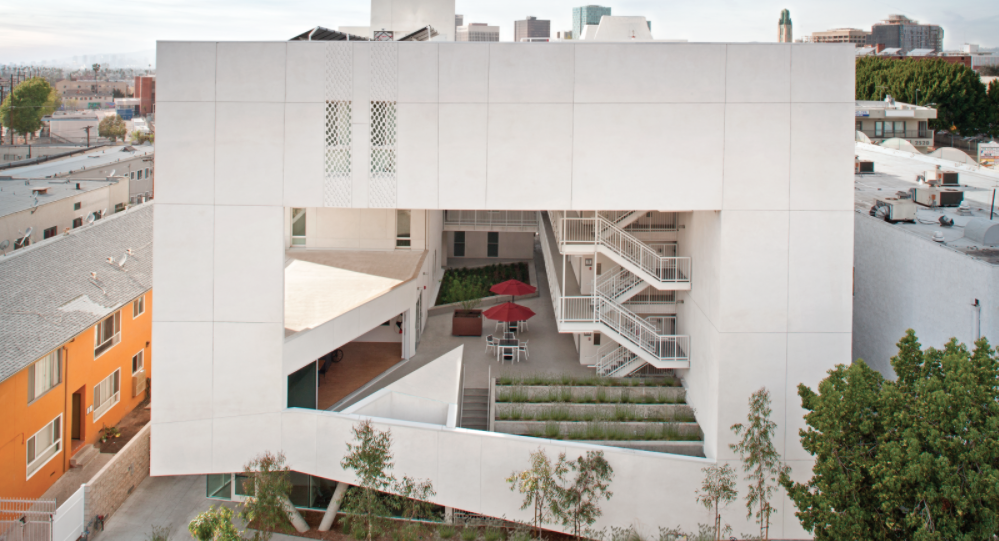For the homeless, the experience of obtaining social services, whether in a soup kitchen, shelter, or free clinic, often means having to encounter institutional buildings marked by dingy walls, stained floors, and annoying fluorescent lights.
“The message people get is, ‘We don’t really care very much about you,’” says Mike Alvidrez, CEO, Skid Row Housing Trust, Los Angeles. “We don’t see that as a healthy way to change one’s life.”
Alvidrez says it’s almost impossible for people to overcome mental, social, and medical problems while they’re homeless. Skid Row Housing Trust’s approach is to provide housing first, so that problems emanating from prolonged poverty, poor health, disabilities, mental illness, or addiction can be addressed, and people can go on to lead “safe, stable lives in wellness.”
To fulfill that mission, Skid Row Housing Trust works with award-winning architects to create masterfully designed “supportive” apartment buildings. “We want these buildings to feel inspirational and aspirational, so residents feel proud of where they live and aspire to do more,” says Alvidrez.
That philosophy certainly applies to The Six, an 18,390-sf building designed by Los Angeles–based Brooks + Scarpa. The Six provides 52 apartments and studio efficiencies for formerly homeless individuals; 18 of the units have been set aside for veterans. The name comes from the military expression “Got your six,” meaning “I’ve got your back.”
DESIGNING A PLACE FOR HEALING
The Six is located at 811 South Carondelet Street in MacArthur Park, one of the highest-density neighborhoods in the U. S.—38,000 per square mile. The architects were aware that successful recovery and rehabilitation for Skid Row Housing’s clients depended on the ability of formerly homeless individuals to be reintroduced into society.
The design of The Six purposely deemphasizes personal space in favor of community space where residents can make connections organically—to others, and to their surroundings.
“Projects like this tend to become very large compact masses, and light and ventilation become real problems,” says Lawrence Scarpa, FAIA, LEED AP, CEO, Brooks + Scarpa. “We wanted the units to be open and light-filled, with good cross-ventilation, and still have privacy for tenants.”

The view from the second-floor podium courtyard into the community room. “For the veterans and other tenants who are suffering from schizophrenia and other problems, the courtyard and community room get them to be among other people,” says Lead Designer Larry Scarpa, FAIA. Photo: Tara Wujcik
The solution was to create a huge five-story white cube with massive holes punched into three sides. Skid Row Housing’s Alvidrez admits that The Six really stands out. “Let’s face it, it’s a box, but, man, what a box!” he says. “The opening in the front is what you notice first: ‘Hey, there’s a big hole in that building. What the hell is that about?’ It sets up a conversation with the community. Homelessness is something we need to talk about. The solution needs to be loud and proud.”
The varying size of the punched holes induces cross-ventilation that takes advantage of the local climate and prevailing breezes. “The air really flows through,” says Brooks + Scarpa Design/Project Manager Diane Thepkhounphithack. The units have huge casement windows that catch the wind. Transom windows over the entry doors allow air and light to penetrate the living spaces.
The emphasis on natural light and airflow reinforces the designers’ focus on promoting physical and emotional healing. “With any form of recovery, being exposed to light, ventilation, and beautiful weather can make a huge difference,” Thepkhounphithack says.
GIVING TENANTS MEANINGFUL OPTIONS
To encourage residents to get out and about instead of hunkering in their rooms, the 45 studio efficiencies (350 sf) and seven one-bedroom units (500 sf) provide just enough room for a bed, bathroom, and small kitchen. Rents are based on income.
The organic nature of the pierced walls opens up an extensive courtyard on the second floor that connects to a community space with sliding glass doors (which are usually kept open during the day). This nexus between the courtyard and the community space can, depending on the needs of the tenant, provide opportunity either for involvement with others, or for privacy.
“Our task was to allow people to interact with others, but at their own choosing,” says Scarpa. “The community room is wide open and connects to the courtyard, so people can interact but still be part of the bigger space.”
The open frame of the building gives residents a feeling of privacy despite the intense density of the neighborhood. “As soon as you put a frame around something, you feel a sense of separation, in a good way,” says Thepkhounphithack. “When you’re on the podium deck, technically you’re exposed because people can see in, but you feel pulled back, and you still have a sense of privacy.”

James Grahn, 53 (right, with residents Tony Hill and Robert Odom), served in the Army Signal Corps in Germany, Texas, and California (1982 to 1991), then did a stint in the National Guard (2001 to 2011). “I had a lot of fun in the army,” he says. Before moving to The Six in May, Grahn lived in a friend’s RV, then wound up in a VA hospital. His last stop was a homeless shelter in downtown LA.
Pathways through the building lead to the staircase that connects to the residential units on the upper floors of the five-story structure. That wayfinding pattern was carefully choreographed.
“It’s not the most efficient way to get around,” says Thepkhounphithack. “The pathways are meant to be meandering, to encourage residents to get outside in communal spaces in order to socialize and reconnect with the community.”
Diana Pescar, Resident Services Coordinator with Skid Row Housing , says she’s pleasantly surprised at how well the community space is working. “They’re playing dominoes out there on the picnic tables, stuff you’d see on Skid Row, but now they’re in this safe environment.”
PROVIDING SORELY NEEDED SERVICES
As with all Skid Row Housing projects, The Six has on-site supportive services: primary medical and mental healthcare, individual and group counseling, health and dental screenings, addiction recovery support, and assistance with obtaining government entitlements.
Three case managers—Pescar, Daniel Myatt, and Shanknika Ainsworth—provide intensive case management for all residents, including peer-group counseling, crisis intervention, and hands-on help with applications for Social Security disability and veterans’ benefits. “Because they’ve been homeless, our residents often don’t have their birth certificates or discharge papers,” says Pescar. “We have a direct line to the VA and can get those documents.”
To foster interaction among the residents, the case managers offer classes in improv acting, music appreciation, cooking on a budget, and flower arrangement. Pescar, who has a degree in art education, says she initially got a lot of grief about the flower class. “Oh, the guys’ll never come! That’s all I heard.” But the class is full every week. “That class has taught me that these men have interests that you wouldn’t think possible—aesthetics, gardening, music,” says Pescar.
NO SHORTAGE OF PROBLEMS TO SOLVE
The Six’s team faced more than its fair share of hurdles. The design was well under way when the project had to be moved to a new site. “We had to scramble to produce a quick concept design to show lenders the project was still viable,” says Thepkhounphithack.
The complicated funding package created another set of problems. Skid Row Housing Trust pulled together $10.1 million from a wide array of sources: National Equity Fund, Los Angeles Housing + Community Investment Department, Housing Authority of the City of Los Angeles, Los Angeles County Department of Health Services, California Tax Credit Allocation Committee, Local Initiatives Support Corp., Federal Home Loan Bank of San Francisco, Charles Schwab Bank, Century Housing Corp., and Wells Fargo.

Mechanical systems are enclosed in decorative sculptural forms. “We worked hard to consolidate hundreds of shafts and exhausts so that our roof wouldn’t become a big mechanical zone,” says Larry Scarpa. Photo: Tara Wujcik
The lenders imposed strict—and immovable—timelines on the team. “If you miss the timeline, they revoke your funding. No fees or fines, they just take your money back,” Thepkhounphithack says. It was a constant race against the clock. Very late in the construction schedule, they discovered a misunderstanding about one lender’s deadline. “We had to finish one or two months earlier than scheduled,” she says. The general conrtractor, Golden Bear Construction, had to frame entire floors in a week.
Permitting also proved a headache. Some of the newer materials the team wanted to use, while not that unusual—for example, a new wood composite screen material—the building department wouldn’t allow because its research department hadn’t tested it.
“What’s good enough for every other building department in the world is not good enough for LA,” says Scarpa. Says Thepkhounphithack, “It was an intense process. We basically lived in the building department.”
MAKING A BOLD STATEMENT
The architectural style of The Six was clearly intended to stand out. Thepkhounphithack says the design of the building was about “propelling the neighborhood forward,” rather than just blending in.
The all-white façade of the five-story structure brings a brightness and tranquility to the building and provides a background to the landscaping (by LandStudio 360 and Brooks + Scarpa). The grass in the planters is bright pink when in bloom; the roof plants are red hot pokers. The stark façade provides a dramatic backsplash to these piercing colors as they come into season and change with time, she says.
In addition to earning LEED for Homes Platinum certification, The Six has already captured a slew of prizes: 2017 National AIA Institute Honor, AIA National Housing Award, AIA California Council Honor Award, AIALA Honor Award, and AIA Sustainability Honor Award.

Luxury sheet vinyl flooring helps keep maintenance under control at The Six. Walls were done in semi-gloss paint (level-four smooth finish) for easy cleaning. Units are ADA-adaptable, with zero-step thresholds and roll-in showers or tubs. Photo: Tara Wujcik
For the project team, the true reward has come in how The Six is helping provide elegant housing at affordable rates to those who were previously on the street. This is especially true for the veterans. Says Thepkhounphithack, “It’s good to have them be part of the future instead of being stuck in the past.”
The biggest benefit for the veterans and other formerly homeless residents, says Skid Row Housing Trust’s Diana Pescar, is that The Six induces “a sense of pride about being deserving of living in a nice place.” Her boss, Mike Alvidrez, puts it this way: “We want them to feel proud that this is their home, their community.”
PROJECT TEAM | THE SIX, LOS ANGELES
CLIENT Skid Row Housing Trust, LLC ARCHITECT Brooks + Scarpa STRUCTURAL ENGINEER John Martin & Associates CIVIL ENGINEER Barbara L. Hall, PE MEP ENGINEER Innovative Engineering Group SPECIFICATIONS Phil Easton LANDSCAPE ARCHITECT Brooks + Scarpa; LandStudio 360 GENERAL CONTRACTOR Golden Bear Construction
Related Stories
| Aug 11, 2010
Triangular tower targets travelers
Chicago-based Goettsch Partners is designing a new mixed-use high-rise for the Chinese city of Dalian, located on the Yellow Sea coast. Developed by Hong Kong-based China Resources Land Limited, the tower will have almost 1.1 million sf, which includes a 377-room Grand Hyatt hotel, 84 apartments, three restaurants, banquet space, and a spa and fitness center.
| Aug 11, 2010
Brooklyn's tallest building reaches 514 feet
With the Brooklyner now topped off, the 514-foot-high apartment tower is Brooklyn's tallest building. Designed by New York-based Gerner Kronick + Valcarcel Architects and developed by The Clarett Group, the soaring 51-story tower is constructed of cast-in-place concrete and clad with window walls and decorative metal panels.
| Aug 11, 2010
RMJM unveils design details for $1B green development in Turkey
RMJM has unveiled the design for the $1 billion Varyap Meridian development it is master planning in Istanbul, Turkey's Atasehir district, a new residential and business district. Set on a highly visible site that features panoramic views stretching from the Bosporus Strait in the west to the Sea of Marmara to the south, the 372,000-square-meter development includes a 60-story tower, 1,500 resi...
| Aug 11, 2010
'Feebate' program to reward green buildings in Portland, Ore.
Officials in Portland, Ore., have proposed a green building incentive program that would be the first of its kind in the U.S. Under the program, new commercial buildings, 20,000 sf or larger, that meet Oregon's state building code would be assessed a fee by the city of up to $3.46/sf. The fee would be waived for buildings that achieve LEED Silver certification from the U.
| Aug 11, 2010
Colonnade fixes setback problem in Brooklyn condo project
The New York firm Scarano Architects was brought in by the developers of Olive Park condominiums in the Williamsburg section of Brooklyn to bring the facility up to code after frame out was completed. The architects designed colonnades along the building's perimeter to create the 15-foot setback required by the New York City Planning Commission.
| Aug 11, 2010
U.S. firm designing massive Taiwan project
MulvannyG2 Architecture is designing one of Taipei, Taiwan's largest urban redevelopment projects. The Bellevue, Wash., firm is working with developer The Global Team Group to create Aquapearl, a mixed-use complex that's part of the Taipei government's "Good Looking Taipei 2010" initiative to spur redevelopment of the city's Songjian District.
| Aug 11, 2010
Recycled Pavers Elevate Rooftop Patio
The new three-story building at 3015 16th Street in Minot, N.D., houses the headquarters of building owner Investors Real Estate Trust (IRET), as well as ground-floor retail space and 71 rental apartments. The 215,000-sf mixed-use building occupies most of the small site, while parking takes up the remainder.
| Aug 11, 2010
Housing America's Heroes 7 Trends in the Design of Homes for the Military
Take a stroll through a new residential housing development at many U.S. military posts, and you'd be hard-pressed to tell it apart from a newer middle-class neighborhood in Anywhere, USA. And that's just the way the service branches want it. The Army, Navy, Air Force, and Marines have all embarked on major housing upgrade programs in the past decade, creating a military housing construction boom.
| Aug 11, 2010
Loft Condo Conversion That's Outside the Box
Few people would have taken a look at a century-old cigar box factory with crumbling masonry and rotted wood beams and envisioned stylish loft condos, but Miles Development Partners did just that. And they made that vision a reality at Box Factory Lofts in historic Ybor City, Fla. Once the largest cigar box plant in the world, the Tampa Box Company produced boxes of many shapes and sizes, spec...
| Aug 11, 2010
World's tallest all-wood residential structure opens in London
At nine stories, the Stadthaus apartment complex in East London is the world’s tallest residential structure constructed entirely in timber and one of the tallest all-wood buildings on the planet. The tower’s structural system consists of cross-laminated timber (CLT) panels pieced together to form load-bearing walls and floors. Even the elevator and stair shafts are constructed of prefabricated CLT.







